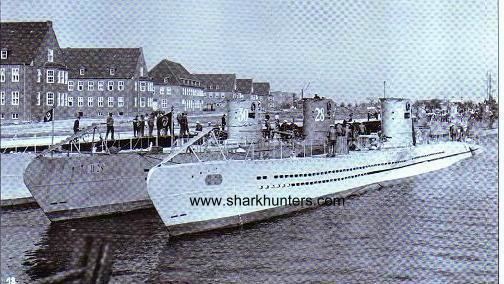Name U-29 Laid down 2 January 1936 Construction started 2 January 1936 Length 64 m Beam 5.85 m | Ordered 1 April 1935 Yard number 910 Commissioned 16 November 1936 Launched 29 August 1936 Draft 4.37 m | |
 | ||
Part of | ||
German submarine U-29 was a Type VIIA U-boat of Nazi Germany's Kriegsmarine during World War II.
Contents
She was laid down on 2 January 1936, launched on 29 August and commissioned on 10 November. During her career U-29 was involved in seven war patrols under the command of Kapitänleutnant Otto Schuhart.
Design
As one of the first ten German Type VII submarines later designated as Type VIIA submarines, U-29 had a displacement of 626 tonnes (616 long tons) when at the surface and 745 tonnes (733 long tons) while submerged. She had a total length of 64.51 m (211 ft 8 in), a pressure hull length of 45.50 m (149 ft 3 in), a beam of 5.85 m (19 ft 2 in), a height of 9.50 m (31 ft 2 in), and a draught of 4.37 m (14 ft 4 in). The submarine was powered by two MAN M 6 V 40/46 four-stroke, six-cylinder diesel engines producing a total of 2,100 to 2,310 metric horsepower (1,540 to 1,700 kW; 2,070 to 2,280 shp) for use while surfaced, two BBC GG UB 720/8 double-acting electric motors producing a total of 750 metric horsepower (550 kW; 740 shp) for use while submerged. She had two shafts and two 1.23 m (4 ft) propellers. The boat was capable of operating at depths of up to 230 metres (750 ft).
The submarine had a maximum surface speed of 17 knots (31 km/h; 20 mph) and a maximum submerged speed of 8 knots (15 km/h; 9.2 mph). When submerged, the boat could operate for 73–94 nautical miles (135–174 km; 84–108 mi) at 4 knots (7.4 km/h; 4.6 mph); when surfaced, she could travel 6,200 nautical miles (11,500 km; 7,100 mi) at 10 knots (19 km/h; 12 mph). U-29 was fitted with five 53.3 cm (21 in) torpedo tubes (four fitted at the bow and one at the stern), eleven torpedoes, one 8.8 cm (3.46 in) SK C/35 naval gun, 220 rounds, and an anti-aircraft gun. The boat had a complement of between forty-four and sixty.
Service history
U-29 was responsible for the first British warship sunk in the war by enemy action, the aircraft carrier HMS Courageous, on 17 September 1939. Three days earlier U-39 had attempted to torpedo HMS Ark Royal, but missed and was sunk by three British destroyers. Two years later U-81 hit Ark Royal with one torpedo, sinking her, but with the loss of only one life.
The commander of the German submarine force, Commodore Karl Dönitz, regarded the sinking of Courageous as "a wonderful success" and it led to widespread jubilation in the Kriegsmarine (German navy). Grand Admiral Erich Raeder, commander of the Kriegsmarine, directed that Schuhart be awarded the Iron Cross First Class and that all other members of the U-29 crew receive the Iron Cross Second Class.
During U-29's career, she sank twelve ships, totaling 67,277 gross register tons (GRT) and one warship of 22,500 tons. At the beginning of 1941, U-29 was removed from front line duty and reassigned to the 24th U-boat Flotilla as a training submarine. The U-boat was used in this role until 17 April 1944 when the she was decommissioned and used for instruction.
Fate
U-29 was scuttled in Kupfermühlen Bay, (east of Flensburg), on 5 May 1945 as part of Operation Regenbogen. The wreck was still in situ as of 1993.
Wolfpacks
U-29 took part in one wolfpack, namely.
Emblem
U-29's emblem was an oak leaf, with an anchor, and a knife or dagger. She also shared this emblem with U-3, U-120, U-747, U-1274 and U-1308.
